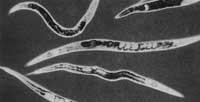Head cells
2000/05/01 Elhuyar Zientzia Iturria: Elhuyar aldizkaria
The body destroys cells that are not useful, that work poorly or that are harmful, and for this purpose it commands the order to commit suicide: one or more proteins reach the nucleus of the cell and this is destroyed in the process called apoptosis. Researchers have known for a long time this mechanism that regulates the number of cells and their relationships, including the one that serves for the correct chiseling of tissues.
However, the malfunction of apoptosis can be caused by certain types of cancer, autoimmune diseases, and degenerative diseases. Knowledge of this biological mechanism can be of great help to improve the understanding and healing of these diseases, as well as to combat diseases such as embolism, heart, or Alzheimer's.
Researchers have used Caenorhabditis elegans worms to study apoptosis and have identified four proteins responsible for the process, called EGL-1, CED-9, CED-4 and CED-3. At the same time, interactions and dependencies between these proteins have been analyzed. It is an important discovery, but there is still much to do, such as the transition from worms to the human body.

Gai honi buruzko eduki gehiago
Elhuyarrek garatutako teknologia





